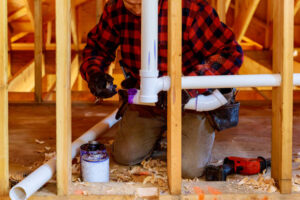Not simply a little irritation, but a foundation leak for your house is a ticking time bomb. Once water discovers a weak area in your foundation, your basement, flooring, even structural integrity is completely lost. Water finds places it shouldn’t quite cleverly. The worst aspect of it is that flashing lights and sirens do not announce these leaks. They hide, subtly devalues your house from the inside out.

The Value of Silence in Alertness
Most homes never find out they have a foundation leak until it is too late. waking up and seeing a flooded basement, wondering, “When did this happen?” The indicators were there all along, really. All you need know is where to look.
If the basement or crawl space smells like an old, wet rag, there is reason for alarm. Mold loves a foundation leak; moisture caught in flooring and walls encourages it.
Unresolved Puddles: Ignoring a chance puddle in your basement is not a mystery. If it is not from a fallen drink or a defective pipe, your foundation could be the source.
Problems with Walls or Floors – Although not all cracks point to issues, water could be leaking through if they start to show up around your wall base or spread.
Flooring that is warped or buckled Not friends are water and wood. If your hardwood floor rises or your carpet smells moist, water is hiding where it shouldn’t be.
For white, powdery residue on basement walls, use fancy language efflorescence. It is left behind as water leaves its minerals behind, seeps through concrete, evaporates.
From what causes foundation leaks?
Water is not temporary. It points out every flaw, opening, every fracture. But why then is it showing up in?
Bad Drainage: Downspouts draining water immediately next to your house? Fantastic idea. Water needs to be diverted from your foundation, not towards it.
Hydrostatic Pressure: Water pushes against your foundation as the ground around your house gets moist. Concrete is sturdy, but eventually time pressure wins.
Thus, shrinkage and expansion of soil: Soils thick in clay shrink dry and swell moist. That constant movement weakens your foundation and finally causes fissures.
Your basement walls are sitting ducks for moisture absorption if they were not sufficiently waterproofed.
In plumbing, water leaks. Under your foundation, a hidden pipe leak is a slow-motion disaster. It softens the ground and opens cracks for growth.
Stopping the Leak Before Your House Is Trashed
You should move fast after a foundation leak has been confirmed. Water damage does not wait for a perfect opportunity; it accelerates quickly.
Seek the source first.
Before you start wall repairs, you have to determine where the water is coming in. Is it seeping through the cracks? Getting off the floor? From pipes, leak? Follow the signals; shine a flashlight in dark locations; if necessary, use moisture meters.
Second step: stop the water exactly at the source.
If the issue is outside, that of rainfall accumulating around your property, first is correcting the drainage. Clear gutters, extend downspouts, slope the ground such that water goes away.

Should it be an indoor problem that of a leaking pipe call a plumber immediately. No do-it-yourself repair job will fix a broken pipe buried under concrete.
Close the divisions in the third stage.
Once the water under control, it is time to close the shop. The process is as follows:
Epoxy or polyurethane injections help significantly with small cracks. They bond with the concrete and exclude water.
Perfect for closing larger fractures; hydraulic cement sets quickly and expands as it dries.
Further seepage will be stopped on inner walls by using a high waterproof coating.
Fourth step: arrange for a drainage system.
Patchwork isn’t enough for continuous leakage. You could need a more long-lasting cure like:
Using perforated pipe and gravel-filled trenches, French drains move water away.
Sump pumps, a lifesaver, gather and discharge water in basements prone to floods before it causes problems.
For outside waterproofing, excavating around your base, laying waterproof membranes, and creating appropriate drains is a heavy-duty solution.
Fifth step: dehumidify it and dry it out
Moisture persists even after the leaks are shut. Mold spores don’t need much help to take over. Run a dehumidifier, open windows if at all possible, and use fans to speed the drying process.
Stopping Tomorrow Foundation Leaks:
Fixing the problem is only half the battle; now you have to stop it from coming back.
See Your Gutters Like a Hawk: Ground directly next to your foundation is inundated with water leaked from blocked gutters. Usually keep them neat.
Make sure the downspouts go at least five feet away from your house. Otherwise, you are basically running the problem over again.
Look for soil erosion; if the earth around your house is sinking, water most likely is building near the foundation. Reach lowest places and keep a gradient sloping away.
Test Your Sump Pump: Don’t assume it runs if you have one. Pour in water; confirm it turns on. Worse than not having a sump pump at all is a failed one.
Seal Vents and Basement Windows: Water seeps in through vents and cracks around windows. A bit of caulking and weatherstripping will go a long way.

The cost of ignoring a foundation leak
If you think a little stream of water is not really important, think twice. Ignored, a foundation leak could become a major tragedy costing money. Water eats concrete, compromises systems of support, and promotes mold to turn your house into a scientific project. From a damp area, drooping floors, crumbling walls, or worst-case scenario catastrophic foundation failure might all follow.
And then one takes health into account. Along with smelling bad, mold spores cause allergies, asthma, and respiratory issues. If you or a relative suddenly cough more or experience persistent congestion, your basement can be the invisible perpetrator.
Procrastinating financially is a bad gamble. Foundation stabilization? A minor fracture repair could run several hundred dollars. Thousands are present. Apart from waterproofing, complete excavation as well? Just over $10,000. A reasonable fix becomes a complete redesign when too much waiting is involved.
Read more: slot online


